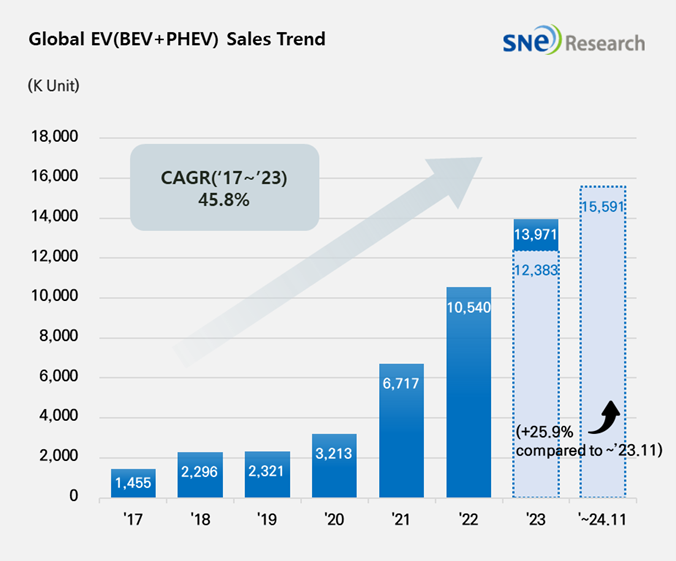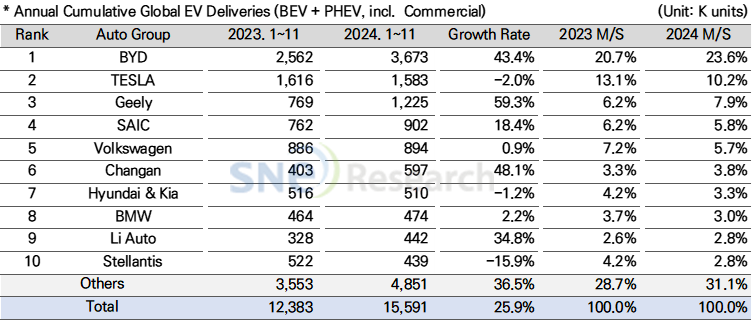Global[1] EV Deliveries[2] from January to November 2024 Reach Approximately 15.59 Million Units, Up 25.9% Year-on-Year
-
BYD Secures Global EV Sales Crown with 3.67 Million Units Delivered in November
2024
In the
January-November 2024 period, the total number of registered EVs worldwide
amounted to approximately 15.59 million units, reflecting a 25.9% increase
compared to the previous year.

(Source: December 2024 Global Monthly EV and
Battery Monthly Tracker, SNE Research)
Tesla,
ranking second, saw a 2.0% year-on-year decline as its Model 3 and Model Y
accounted for approximately 95% of its total sales. In Europe, sales fell by
12.9% compared to the same period last year, while North America experienced a
7.0% drop. Tesla plans to produce a budget-friendly new model by mid-2025 and
aims to improve its performance in 2025 through advancements in Full
Self-Driving (FSD) technology.
Geely
Group secured third place. Its compact EV, Panda (熊猫) Mini, sold over 120,000
units in the Chinese domestic market. Additionally, the premium brand ZEEKR (极氪) achieved sales of 99,000 ZEEKR
001 units, recording the highest growth rate among major automakers at 59.3%.
Like BYD, Geely Group is focusing on the mid-to-high-end market with its
sub-brands Galaxy (银河)
and LYNK & CO (领克).

(Source:
December 2024 Global EV and Battery Monthly Tracker, SNE Research)
Hyundai plans to produce at least five new
EV models in the U.S. by 2025 to meet IRA requirements, potentially receiving
tax credits of up to $7,500 per unit. However, with the incoming Trump
administration's pledge to repeal or reduce subsidies, Hyundai is expected to
adapt flexibly to changing conditions to strengthen its presence in the U.S.
market.

(Source: December 2024 Global Monthly EV and
Battery Monthly Tracker, SNE Research)
By region,
China accounted for 58.8% of the global EV market, maintaining its position as
the largest EV market with a year-on-year growth rate of 39.7%. China continues
to drive global EV growth.
Europe,
which has been most impacted by the EV chasm, experienced a 0.8% year-on-year
decline in EV deliveries, while sales of hybrid electric vehicles (HEVs)
increased by 16.2% over the same period. The European Union has eased Euro 7
automotive regulations, reducing the burden on European automakers to increase
the proportion of EV sales. However, the imposition of additional tariffs on
Chinese EVs has negatively affected the sales of brands such as Geely and SAIC,
slowing the overall pace of electrification in Europe.
In North
America, EV sales grew by 10.1% year-on-year. Despite the implementation of the
IRA policy, sluggish EV demand has persisted. President-elect Trump has
announced plans to end mandatory EV adoption on his first day in office. This
has led to increased demand for hybrid vehicles, prompting OEMs to focus more
on hybrid development. Recently, several OEMs, including Hyundai Motor Group,
have announced plans to develop EREVs (Extended-Range Electric Vehicles) to
actively respond to the growing hybrid demand.
The EV
market in Asia (excluding China) and other regions has continued to expand
rapidly, recording double-digit growth rates despite being in the chasm phase.
Notably, Chinese EV OEMs have been taking the lead in emerging markets,
accelerating the adoption of EVs in developing countries.
Meanwhile,
in major EV markets like the U.S. and Europe, measures have been taken to
counter the growing market share of competitively priced Chinese EVs by raising
tariff barriers and protecting domestic EV industries. As a result, traditional
automakers are focusing on bridging the price gap between EVs and internal
combustion engine vehicles, while also exploring new business areas such as
autonomous driving technology. These efforts mark a critical turning point as
the industry prepares for the mainstream adoption of EVs.
[2] Based on electric vehicles (BEV+PHEV) delivered to customers or registered during the relevant period

